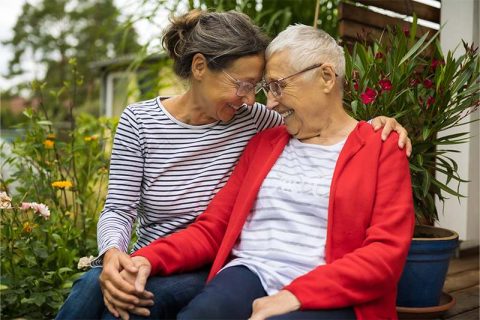February 10, 2025 by

You ask a simple question: “What would you like for breakfast?” But rather than a response, you’re met with hesitation, confusion, and a long pause. You’ve likely experienced moments like this while caring for someone with Alzheimer’s, where words seem just out of reach and conversations feel more like challenges than connections. When verbal communication starts to fade, it’s easy to feel at a loss. But the truth is, connection doesn’t rely solely on words. Nonverbal communication in Alzheimer’s may just be the key you’re looking for to stay connected.
I’ve seen firsthand how a simple gesture, like holding someone’s hand, can communicate love and reassurance far more powerfully than words ever could. These moments remind us that communication doesn’t stop when words fail; it simply shifts to other forms. Nonverbal communication becomes the bridge that allows us to maintain meaningful connections and ensure a loved one with Alzheimer’s feels supported and understood.
Why Nonverbal Communication in Alzheimer’s Matters
Alzheimer’s can make it difficult for individuals to find the words they want or even understand what’s being said to them. Yet, their emotional awareness often remains intact. This means they can sense frustration, joy, love, and calmness, even if they can’t articulate these emotions. Nonverbal communication bridges the gap, allowing you to express empathy, reassurance, and understanding without words.
Simple Ways to Communicate Without Words
Here are five nonverbal ways to connect with someone with dementia:
- Eye contact: Meeting someone’s gaze can be incredibly grounding. For a person with Alzheimer’s, eye contact conveys that you’re present and engaged. It helps them feel seen and valued, even if their memory struggles to place who you are.
- Touch: A warm hand on their shoulder, holding their hand, or a gentle pat on the back can communicate comfort and love. Touch has a way of bypassing confusion, reaching straight to the heart.
- Facial expressions: A smile or a calm, reassuring expression speaks volumes. Your face can reflect emotions that words may fail to convey, such as kindness, patience, and understanding.
- Body language: Open, inviting posture shows you’re approachable. Avoid crossed arms or abrupt movements, which may be perceived as frustration or impatience.
- Tone of voice: Even when words aren’t understood, your tone is. Speak softly and warmly, as it can help reduce anxiety and foster a sense of calm.
Activities That Encourage Nonverbal Interaction
Engaging in simple, shared activities can enhance nonverbal communication in Alzheimer’s. Try brushing their hair, listening to music, or drawing together—moments that don’t require words. It’s about being present and creating shared experiences.
For instance, many people with Alzheimer’s respond well to music. Singing or playing familiar tunes can spark joy and provide a way to connect that feels natural and uplifting.
Watch for Their Nonverbal Cues as Well
Communication is a two-way street. Your family member is likely sharing their feelings nonverbally, too. Learn to recognize their cues:
- Facial expressions: A furrowed brow may indicate discomfort or confusion, while a smile can signal contentment.
- Gestures: Pointing or reaching for something might be their way of indicating a need.
- Sounds: Humming, sighing, or other vocalizations can convey feelings when words don’t come.
The next time you’re struggling for the right words, remember that silence isn’t the absence of communication. It’s an opportunity to speak with your eyes, your hands, and your heart. After all, some of the most meaningful connections don’t require words at all.
Want Additional Help and Resources?
With At Home Independent Living, our caregivers are experts in caring for individuals with Alzheimer’s while supporting those who love them. Contact us at (315) 579-HOME (4663) to learn more about our skilled Alzheimer’s care in Syracuse, Camillus, Clay, and throughout Central New York.
